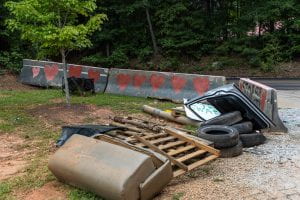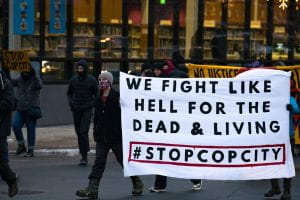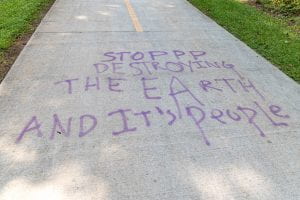[ad_1]
I grew up in the Atlanta metropolitan area. Not inside the perimeter as one might say, I spent my childhood in the forests for hours at a time. My brother and I never grew bored of the endless possibilities and freedom we felt among the oaks: they are some of my most treasured memories. So, whenever we drove into Atlanta proper, I would watch the trees blur by as we encroached further to the city’s heart, well past the notorious highway 285 that encircles it. I always had a tree in sight no matter the distance we ventured into the city, and it always reminded me that home could extend and coincide with a vibrant metropolis rising ever closer in my sight. This always soothed me and put me at peace.
Not all is peaceful in the forest, however.
When protesting is rebranded as domestic terrorism
Since the quiet release of plans to demolish South River Forest (also known as the Old Atlanta Prison Farm) in 2021, protesters have been camping in the forest for months. Local organizations have banded together in order to advocate for the forest and resist police attempts to forcibly remove protesters. These organizations include Defend the Atlanta Forest, Community Movement Builders, a Black-led nonprofit serving working-class and poor Black people, and the newly formed Stop Cop City group.
These organizations have intersecting goals that culminate in mutual aid to stop the construction of the Atlanta Public Safety Training Center known as “Cop City.” Leaders from the Community Movement Builders described the project as a “war base” wherein “police will learn military-like maneuvers to kill Black people and control our bodies and movements.”
One reason for the clear disdain for the project, aside from the historical implications discussed further below, is that the proposed site resides in unincorporated Dekalb county. Thus, those living in the neighborhood had no representatives on the council that approved the project in the first place. After public outrage at the lack of transparency and community engagement, the Atlanta council begrudgingly allowed public comments before the vote in September 2021. The council received 17 hours of recording on the proposal with 70% (or 12 hours) expressing opposition. The plan still passed 10-4.

Protesters have created makeshift barricades from mounds of illegally dumped material such as automobiles and tires in the forest. There is no water or electricity in the encampments so the protesters live very frugally to defend their beliefs. Access to water has continued to be an issue as police try to cut off supplies in an attempt to disperse the protesters and conduct regular raids and wreaking camps.
Confrontations with the police have only become more frequent: and with more serious consequences. At first, some activists found themselves with trespassing charges, but protests escalated on January 18th when demonstrator Manuel “Tortuguita” Teran, a 26-year-old queer environmental activist, was lethally shot by Georgia state police.

The Georgia Bureau of Investigation released a statement that Tortuguita, they/them, did not “comply with verbal commands” and allegedly shot a Georgia State Patrol trooper who is in stable condition. As a result of these alleged sequence of events, Tortuguita was shot over a dozen times by multiple different firearms and there is no body cam footage of the tragedy.
Now, the state is planning to convict 18 activists of domestic terrorism charges which holds a possible sentence of up to 35 years.
Local authorities have continued to falsely claim that organizations involved in resisting police development plans are “domestic violent extremists.” During the bail hearing for those arrested on Jan. 18th, bail was denied to four activists while two were given the unprecedented amount of $355,000, along with conditions for ankle monitors and curfews.
What once would have been considered a sit-in protest has now been twisted into “domestic terrorism.”
So what is Cop City?
Cop City is the name that has been given to the project to construct the nation’s largest police training facility.
Considered a private-public venture between the city of Atlanta and the Atlanta Police Foundation (APF), the 85 acres slotted to be turned into a police compound would cost $90 million to construct. Renderings of the project include indoor and outdoor shooting ranges, an auditorium, classrooms, a space dedicated to explosion tests, and a mock miniature city to practice high-speed chases and burn-building training.
The Public Safety Training Academy Advisory Council was formed under the previous mayor, Keisha Lance Bottoms, on Jan. 4, 2021. According to investigative work conducted by the Mainline, a woman-led independent magazine based in Atlanta, the council was comprised entirely by “government, police, and fire officials, including Chief Operating Officer Jon Keen and APF CEO and President Dave Wilkinson.”
After meeting on Jan. 22, Feb. 12, March 4, and March 26 in 2021, the plan that would become Ordinance No. 21-O-0367 (Cop City) was introduced on June 7th the same year. It was passed shortly thereafter on September 8th, 2021.
Two-thirds of the costs ($60 million) to construct Cop City are coming from corporate donors such as Chick-Fil-A and Delta. Otherwise, despite the desperate and apparent need for affordable housing, food, and other life-affirming infrastructures, the remaining third of the costs ($30 million) is to be paid by taxpayers.
The land is currently under lease to the Atlanta Police Foundation for only $10 a year (see page 10) and construction started this February.
Hidden racist history of the forest continued with the development of Cop City
Before South River Forest became known as such, located in the bustling perimeter of Atlanta’s sprawling metropolitan, the land belonged to the Muscogee Creek nation. In the early 19th century, these people were forcibly removed from their land by ever-encroaching settlers on the East coast and South Florida.
In 1821, Georgia held its fourth land lottery, dividing the Muscogee Creek home into 202.5 acres. Between an 11-year period (1827-38), 23,000 Muscogee were driven from their lands by white, enslaving men.
Soon after, the land became a part of a complex of plantations that exploited the labor of enslaved people. The proposed South River Forest zone contained at least 9 plantations. The names of these plantation owners will not be given here, however, to learn some of the known names of enslaved peoples residing in this area, please read this article.
Eventually, this land was sold to the city of Atlanta which was then used as a city-run forced agricultural labor prison that ran uninterrupted from 1920 to nearly 1990, being officially shuttered in 1995.
Originally, the land became the first “honor farm” in the state, allowing trustworthy prisoners and those with minor infractions to work off their time. This was only a mask for a new form of slavery, cruelty, and so much worse as the Prison Farm ran, without clear archived records, for decades. The last official record comes from a 1971 health inspection record.

There are no official reports on the number of people who died under the inhumane working conditions, but there is a widespread belief that some inmates who died were buried in unmarked graves though none have been found yet. A little of what we know is troubling at best and stomach-churning at worse. In 1941, a prison superintendent reported housing 9 Black prisoners in a 12 ft space, alongside numerous reports of sexual violence from guards, and inmate deaths, often under suspect circumstances.
In one example, prisoners were allowed to handle Sulfotep, which was only contained in unlabeled squeeze bottles and is an extremely toxic chemical pesticide only supposed to be dispensed by licensed company personnel. We know this because of the death of Leroy Horton, who was serving only a 20-day sentence, and who had been sprayed with the substance by another inmate at his own request after contracting lice at the prison. He served only four days of his sentence and died three weeks later due to these gross malpractices in safety protocols and sanitary living conditions.
Now, the land is once more under contract by state policing structures.
Benefits and necessity of urban forests
Atlanta has been called the “City in the Forest” for its vast canopy coverage and abundance of trees within the city. That is because Atlanta leads the nation and major metropolitan cities in canopy coverage at 47.9 percent.
The canopy is not distributed evenly across the city, rather it decreases as one approaches downtown and increases as one approaches the outskirts, making the presence of South River Forest within the perimeter that much more extraordinary. Researchers also found that the lowest canopy coverage was along transportation corridors, but was over 90 percent along stream corridors and in nature preserves.
More and more cities are tracking the number of trees they foster because of the multitude of benefits they offer. This ranges from combatting urban heat island effects, reducing heating and cooling costs overall, providing blue/green space which improves mental health, acting as stormwater management to control flooding, and sequestering carbon thus improving air quality, combatting carbon emissions and climate change.
Results from a Montgomery, Alabama analysis found that urban forests removed 3.2 million lbs of pollutants from the air annually which is valued at $7.9 million. Moreover, the urban forest sequestered 11,263 tons of carbon each year and stored a total of 1.45 million tons of carbon.
In Atlanta, climate scientists have warned that destroying woods will make the city more susceptible to flooding and dangerously hot temperatures. Other concerns over the South River Forest area are worsened air quality due to construction, fires, and weapons training. In this mainly Black part of metro Atlanta, people have been historically neglected. According to the US Census, 75 percent of the neighborhoods near the forest are Black and suffer from high poverty rates and health challenges like diabetes and asthma.
The Sierra Club Georgia Chapter issued a statement on behalf of Black and Latinx community members, who have long been victims of environmental injustice and pollution within the city, stating their vehement opposition to the destruction of the South River Forest.
Intersections of social ecology and human rights
In recent years, there has been a burgeoning movement to connect ecological and social issues together: known as the theory of social ecology. Murray Bookchin, a pioneer in the environmental movement and social theorist, has stated that ecological problems stem from social issues which in turn are exacerbated by ecological destruction. This vicious cycle has become the driving force behind new movements to address climate change and foster more awareness of the interdependence of people and their environment. Without this widespread recognition, social-ecological theorists have argued that hierarchical societies that rely on violent institutions like prisons and police are more likely to treat their environment and people as entities to be dominated, conquered, and/or controlled.
In the case of the South River Forest/Cop City contention, this theoretical framework can be easily illustrated, alongside numerous normative international human rights standards.

Firstly, the plans to develop Cop City were done so surreptitiously; there were no public announcements on the proposal before voting, nor were community members and organizations/specialists asked to participate in the development of the plans. Secondly, the council that approved the plans was not elected by anyone from the community in which the Cop City construction will take place. These are prime disregards for political and public representation: foundational blocks for democratic governance, rule of law, and social inclusion. From the Office of the High Commissioner for Human Rights (OHCHR):
“Participation rights are inseparably linked to other human rights such as the rights to peaceful assembly and association, freedom of opinion and expression and the rights to education and to information.”
Next, the economic and social human rights of the South River Forest community are also being threatened. Economically, once again without any representative input, ⅓ of the cost ($30 million) is to be paid by taxpayers. Socially, each human has the right “to social protection, to an adequate standard of living and to the highest attainable standards of physical and mental well-being.” These rights are being threatened by the gross environmental degradation of a low-income community that already suffers from health conditions such as asthma. Moreover, it has long been scientifically proven that blue-green space increases one’s mental health 一 an explicitly aforementioned social right.
Lastly, we come to environmental rights. The task of succinctly explaining them can be a lot, I encourage readers to look on our site in the “Environmental Rights” category for even more insight. However, in this case, where the environment is the key concern of protest, one should return again to social-ecological theory. In human rights, the right to health found in the International Covenant on Economic, Social, and Cultural Rights, cannot be fully achieved in an environment that contributes to worse air quality, mental health, and dangerously high temperatures. The right to security, found in Article 3 of the UDHR, cannot be achieved in an environment where the community is under threat of more flooding, subject to burns, bombs, and shooting daily, and lives in fear of violence. And this can go on and on.
Ultimately, this issue is complex and multifaceted: and it deserves public and civilian representation and more time than 7 months of deliberation to destroy a forest hundreds of years old.
Offer your support and learn more below:
[ad_2]




